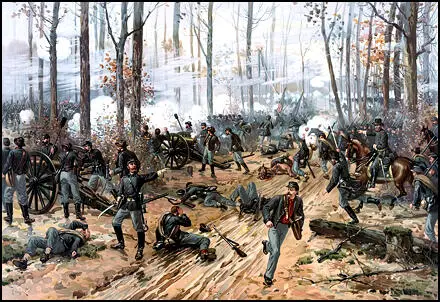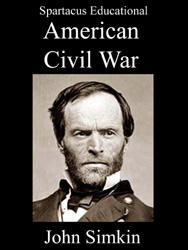Shiloh
In February, 1862 Ulysses S. Grant took his army along the Tennessee River with a flotilla of gunboats and captured Fort Henry. This broke the communications of the extended Confederate line and Joseph E. Johnston decided to withdraw his main army to Nashville. He left 15,000 men to protect Fort Donelson on the Cumberland River but this was not enough and Grant had no difficulty taking this prize as well. With western Tennessee now secured, Abraham Lincoln was now able to set up a Union government in Nashville by appointing Andrew Johnson as its new governor.
After capturing Fort Donelson, Ulysses S. Grant advanced up the Tennessee River and established the headquarters of the Army of Tennessee at Savannah. Grant then arranged for his troops to join with Army of the Ohio, led by General Don Carlos Buell. General Albert S. Johnston decided to defeat Grant before Buell arrived.

On 6th April, Albert S. Johnston and Pierre T. Beauregard and 55,000 members of the Confederate Army attacked Grant's army near Shiloh Church, in Hardin, Tennessee. Taken by surprise, Grant's army suffered heavy losses until the arrival of General Don Carlos Buell and reinforcements the following day.
During the fighting Albert S. Johnston was killed and the new commander, Pierre T. Beauregard, decided to retreat to Corinth, Mississippi. Shiloh was the greatest battle so far of the Civil War. The Union Army suffered 13,000 casualties and the Confederate Army lost 10,000. These figures were questioned by Ulysses S. Grant who claimed that Confederates lost many more than he did.
Primary Sources
(1) Ulysses Grant, Personal Memoirs of U. S. Grant (1885)
Some two or three miles from Pittsburg landing was a log meeting house called Shiloh. It stood on the ridge which divides the waters of Snake and Lick creeks, the former emptying into the Tennessee just north of Pittsburg landing, and the later south. This point was the key to our position and was held by Sherman. His division was at that time wholly raw, no part of it ever having been in an engagement; but I thought this deficiency was more than made up by the superiority of the commander.
The nature of this battle was such that cavalry could not be used in front; I therefore formed ours into line in rear, to stop stragglers - to whom there were many. When there would be enough of them to make a show, and after they had recovered from their fright, they would be sent to reinforce some part of the line which needed support, without regard to their companies, regiments or brigades.
General Albert Sidney Johnston, who commanded the Confederate forces at the beginning of the battle, was disabled by a wound on the afternoon of the first day. This wound, as I understood afterwards, was not necessarily fatal, or even dangerous. But he was a man who would not abandon what he deemed an important trust in the face of danger and consequently continued in the saddle, commanding, until so exhausted by the loss of blood that he had to be taken from his horse, and soon after died.
General Beauregard was next in rank to Johnston and succeeded to the command, which he retained to the close of the battle and during the subsequent retreat on Corinth, as well as in the siege of that place. His tactics have been severely criticized by Confederate writers, but I do not believe his fallen chief could have done any better under the circumstances. Some of these critics claim that Shiloh was won when Johnson fell, and that if he had not fallen the army under me would have been annihilated or captured.
Our loss in the two days' fight was 1,754 killed, 8,408 wounded and 2,885 missing. Of these, 2,103 were in the Army of the Ohio. Beauregard reported a total loss of 10,699, of whom 1,728 were killed, 8,012 wounded and 957 missing. This estimate must be incorrect. We buried, by actual count, more of the enemy's dead alone than is here reported, and 4,000 was the estimate of the burial parties for the whole field.
(2) William Sherman wrote about the battle of Shiloh in his memoirs that were published in 1875.
Probably no single battle of the war gave rise to such wild and damaging reports. It was publicly asserted at the North that our army was taken completely by surprise; that the rebels caught us in our tents; bayoneted the men in their beds; that General Grant was drunk; that Buell's opportune arrival saved the Army of the Tennessee from utter annihilation, etc. The controversy was started and kept up, mostly to the personal prejudice of General Grant, who as usual maintained an imperturbable silence.
The rebel army, commanded by General Albert Sidney Johnson, was, according to their own reports and admissions, forty-five thousand strong, had the momentum of attack, and beyond all question fought skillfully from early morning till about 2 p.m. when their commander-in-chief was killed by ball in the calf of his leg, which penetrated the boot and severed the main artery. There was then a perceptible lull for a couple of hours, when the attack was renewed, but with much less vehemence, and continued up to dark.
Beauregard afterward reported his entire loss at 10,699. Our aggregate loss, made up from official statements, shows 1700 killed, 7,495 wounded and 3,022 prisoners; aggregate, 12,217, of which 2,167 were in Buell's army, leaving for that of Grant 10,050.
(3) After the war Ambrose Bierce wrote an article, What I Saw of Shiloh, about arriving with General Don Carlos Buell after the Battle of Shiloh.
There were men enough; all dead, apparently, except one, who lay near where I halted my platoon to await the slower movements of the line - a federal sergeant, variously hurt, who had been a fine giant in his time. He lay face upward, taking in his breath in convulsive, rattling snorts, and blowing it out in sputters of froth which crawled creamily down his cheek, piling itself alongside his neck and ears. A bullet had clipped a groove in his skull, above the temple; from this the brain protruded in bosses, dropping off in flakes and strings.
The woods had caught fire and the bodies had been cremated. They lay, half buried in ashes; some in the unlovely looseness of attitude denoting sudden death by the bullet, but by far the greater number in postures of agony that told of the tormenting flames. Their clothing was half burnt away - their hair and beard entirely; the rain had come too late to save their nails. Some were swollen to double girth; others shriveled to manikins. According to degree of exposure, their faces were bloated and black or yellow and shrunken. The contraction of muscles which had given claws for hands had cursed each countenance with a hideous grin.
(4) Josephine Clifford saw the wounded Union Army soldiers at Shiloh being transported along the Tennessee River to St. Louis.
It was a long procession of litters and stretchers moving from the steamer lying at the levee at St. Louis to the hastily erected military hospital farther uptown. Most of the wounded soldiers had their faces covered; but wherever a hand was seen, the skin on it was shriveled and wrinkled, from the rain that had fallen on these poor fellows so long.


